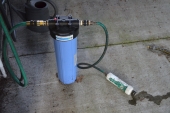
 5
5




 1
1




Permaculture...picking the lock back to Eden since 1978.
Pics of my Forest Garden




Pyroligneous acidWikipedia wrote: The principal components of pyroligneous acid are acetic acid, acetone and methanol. It was once used as a commercial source for acetic acid. In addition, the vinegar often contains 80-90% water along with some 200 organic compounds.
A human being should be able to change a diaper, plan an invasion, butcher a hog, conn a ship, design a building, write a sonnet, balance accounts, build a wall, set a bone, comfort the dying, take orders, give orders, cooperate, act alone, solve equations, analyze a new problem, pitch manure, program a computer, cook a tasty meal, fight efficiently, die gallantly. Specialization is for insects.
-Robert A. Heinlein
 1
1




Chris Kott wrote:
Pyroligneous acidWikipedia wrote: The principal components of pyroligneous acid are acetic acid, acetone and methanol. It was once used as a commercial source for acetic acid. In addition, the vinegar often contains 80-90% water along with some 200 organic compounds.
Why do we want these things? I am assuming for the 200 organic compounds?
One of the other fun things you might create using low-temperature pyrolisis is the wood-tar variant of creosote. This substance's tar-based cousin is responsible for all rail lands having the relative toxicity of superfund sites, though lacking the protections.
I think that instead of building a condenser, unless I had a specific need for a chemical that could be derived in this fashion, I would just ensure that the liquids vapourised into fuel for further pyrolisis, to make more biochar.
-CK
EDIT: Though I think I would like Dr. Redhawk's take on it.
 1
1




A human being should be able to change a diaper, plan an invasion, butcher a hog, conn a ship, design a building, write a sonnet, balance accounts, build a wall, set a bone, comfort the dying, take orders, give orders, cooperate, act alone, solve equations, analyze a new problem, pitch manure, program a computer, cook a tasty meal, fight efficiently, die gallantly. Specialization is for insects.
-Robert A. Heinlein
 4
4




Chris Kott wrote:I think the consensus is that biochar houses microbes that promote healthy soil, and along with conferring a longer-lasting soil structure than more volatile organics, the fact that biochar is the apartment blocks that the worker microbes that build soil live and breed in makes it effective at transforming dirt into living soil.
-CK
Permaculture...picking the lock back to Eden since 1978.
Pics of my Forest Garden
 3
3




Check out Redhawk's soil series: https://permies.com/wiki/redhawk-soil
 1
1




 1
1




'Every time I learn something new, it pushes some old stuff out of my brain.'




A human being should be able to change a diaper, plan an invasion, butcher a hog, conn a ship, design a building, write a sonnet, balance accounts, build a wall, set a bone, comfort the dying, take orders, give orders, cooperate, act alone, solve equations, analyze a new problem, pitch manure, program a computer, cook a tasty meal, fight efficiently, die gallantly. Specialization is for insects.
-Robert A. Heinlein




Mihai Ilie wrote:The most interesting stuff ive read about pyrolineous acid and biochar ,was when on a forum,a farmer from Thailand ( they use biochar and wood vinegar/ pyroligneous acid there for ages) told me that they mix the biochar with the pyroligneous acid and that big chunks of biochar treated this way,simply dissapear after just a year in the ground.
I assumed that the wood acid melts the char but i didnt tested this myself.
In case its true then they dont use it to aerate the soil or grow bacteria but just to feed the carbon similar to the huggelmounds just a lot faster.
Those asians really know a lot about biochar.
He posted pictures and said they grow seedlings in biochar only,without any soil added to it wich its hard to believe but im sure they have their secrets.
I too look for ways to improvise a smoke condenser to make my own pyroligneous acid because in Europe its quite hard to find and the hummic acid from Leonardite costs @ 25 dollars per litter.

|
Remember to always leap before you look. But always take the time to smell the tiny ads:
Freaky Cheap Heat - 2 hour movie - HD streaming
https://permies.com/wiki/238453/Freaky-Cheap-Heat-hour-movie
|



